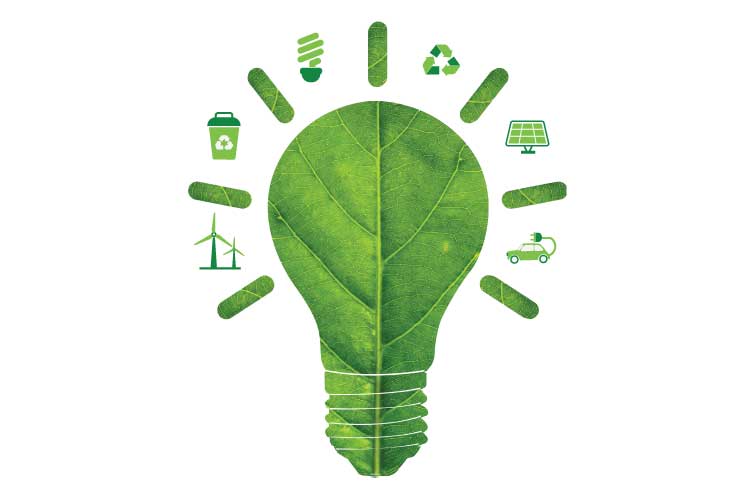Earlier this year, at the heavily charged 26th session of the Conference of the Parties (COP26), India’s Prime Minister Narendra Modi pledged to cut emissions to net zero by 2070, reduce carbon emissions by one billion tonnes and raise the share of renewables in the energy mix to 50% by 2030, besides other commitments. The conference also put the focus back on the need for sustainable development and the necessity of getting corporates on board to drive an environment-friendly agenda. At the COP26, António Guterres, Secretary-General of the United Nations sounded a clarion call to businesses to join the fight against the global climate crisis. “Companies everywhere are recognising that sustainable business is good business; that decarbonising operations and supply chain is not just the right thing, but the smart thing to do. Consumers expect it. Employees demand it. And our future depends on it”, Guterres had said. India’s vow to turn net zero by 2070 therefore will need to be wholeheartedly supported by brands, businesses, and consumers. We take a closer look at the increasingly eco-conscious Indian consumers and the sustainability efforts of Indian brands.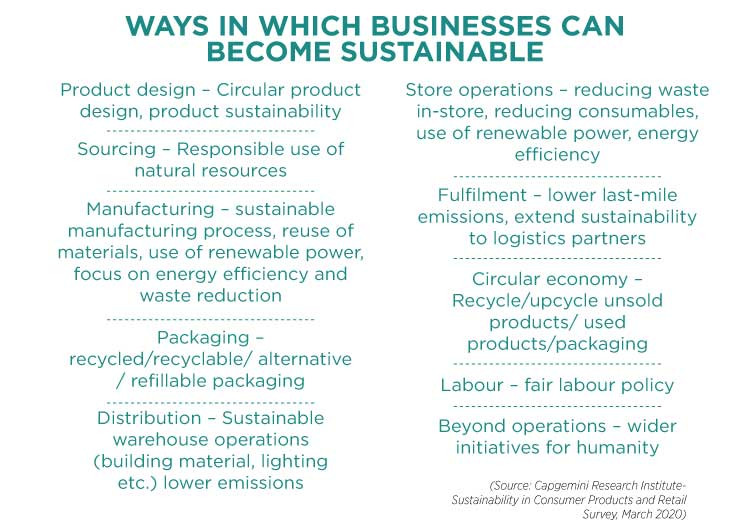
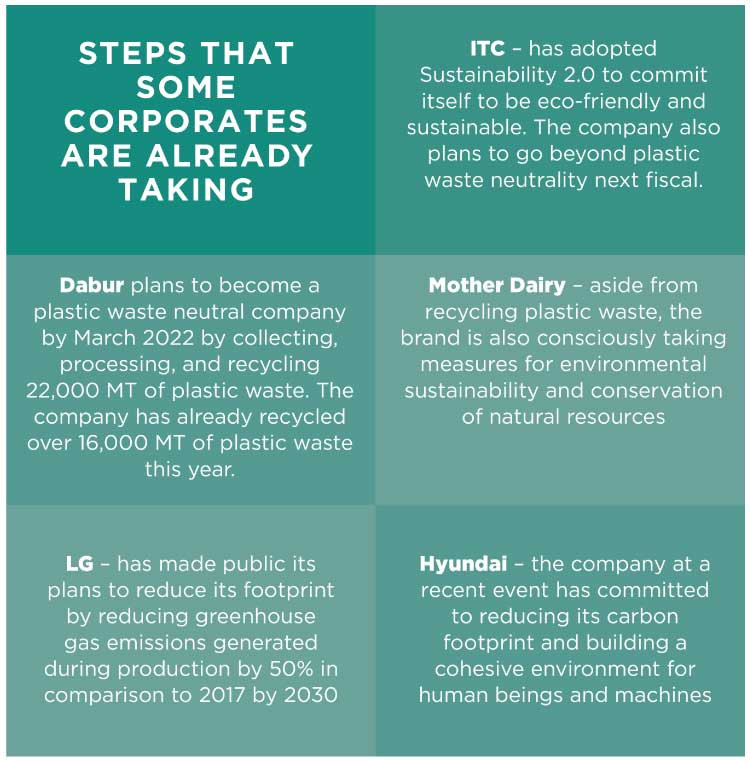
The ever-expanding middle class
While India’s capita emission may be low, as the country’s middle class and industries grow, it becomes important for consumers to adopt sustainability. Brands also need to drive responsible consumption. “As more and more people in India join middle class, we don’t have enough renewable energy, homes are not efficient in terms of  heating, cities are designed in such a way that they aren’t walkable, and public transport is weak. It can put massive pressure on the environment”, says Joe Phelan, India Director, World Business Council for Sustainable Development (WBSCD). It’s a CEO-led global forum that has worked with business houses like Tata Group, Godrej, Yes Bank, Aditya Birla Group, Jain Irrigation, Hindustan Unilever, and Shell in India.
heating, cities are designed in such a way that they aren’t walkable, and public transport is weak. It can put massive pressure on the environment”, says Joe Phelan, India Director, World Business Council for Sustainable Development (WBSCD). It’s a CEO-led global forum that has worked with business houses like Tata Group, Godrej, Yes Bank, Aditya Birla Group, Jain Irrigation, Hindustan Unilever, and Shell in India.
The road to meeting climate goals lies in the adoption of a sustainable lifestyle. How aggressively the world acts to curb greenhouse gases, protect its forests, adopt clean and efficient energy and roll out green technology in the next nine years will be critical. Or in simpler words, how consumers eat, travel, wear clothes, electrify or heat their homes will determine the fate of the planet.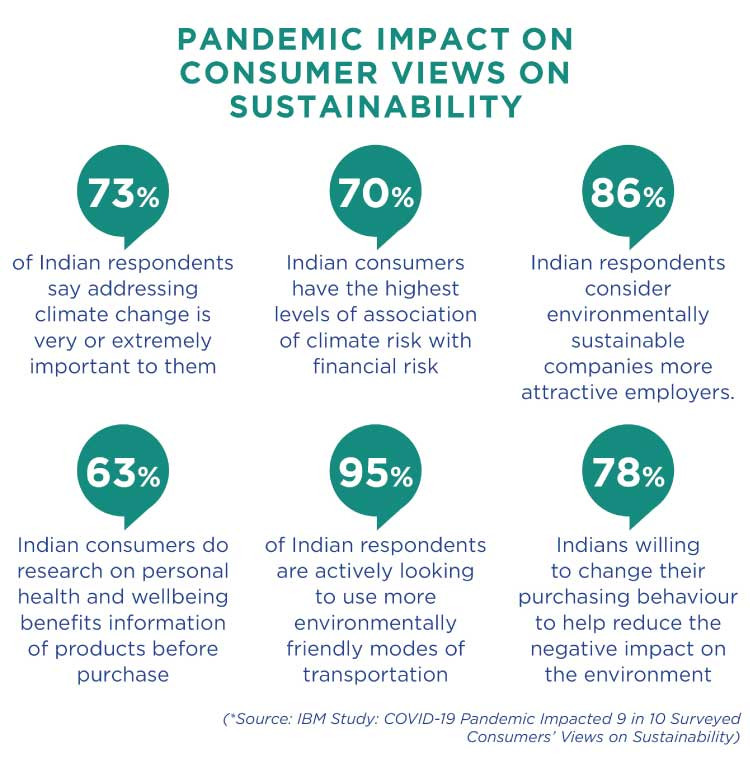
COVID-19: the point of inflection
The need for sustainability means that brands will have to make a 360-degree shift in their entire value chain – from the product design and sourcing of the raw material to manufacturing, marketing, community welfare, etc. 
“We’ve also noticed in our recent research that consumers who value sustainable brands also start to rate the other parameters like technology, innovation and future-readiness, better. These customers, millennials, and Gen Z, are going to be the future consumers of our brand and all other brands. So it is important that we look at their  needs and consumption pre-pandemic and post-pandemic”, says Virat Khullar, Group Head, Marketing at Hyundai India.
needs and consumption pre-pandemic and post-pandemic”, says Virat Khullar, Group Head, Marketing at Hyundai India.
The pandemic has served to underscore the need to have robust health. The conversations around clean air, climate change, and biodiversity became shriller. The pandemic has become a point of inflection; people are suddenly switching over towards natural products. “There are several studies and data that show that there is a higher bent towards adopting sustainable products which are more environment-friendly, and organic. Today marketers are going one step ahead  to see how they can be more sustainable”, says Piyali Chatterjee, Senior Vice President, Head-CX Practice at Hansa Research Group.
to see how they can be more sustainable”, says Piyali Chatterjee, Senior Vice President, Head-CX Practice at Hansa Research Group.
A Capgemini Research Institute study of 2020 too found a correlation between sustainability and consumer purchase patterns. The report clearly highlighted the correlation between sustainability and consumer decisions, noting that social responsibility, inclusiveness, or environmental impact have been shown to affect the purchase decisions of 79% of consumers surveyed.
Sustainability as brand differentiator  Chatterjee also observes that many brands have started using sustainability as a product differentiator and a platform to showcase innovation. Josy Paul, Chairman, BBDO India, supports the argument. “When companies provide a sustainability narrative about their product or service, the consumer feels immensely valued, thus leading to increased desirability and loyalty”. He adds that consumers do not just pick the product; they buy the brand’s story. “It connects with who they believe they are. It is their proof, their identity. It helps them reinforce their perception about themselves”, Paul remarks.
Chatterjee also observes that many brands have started using sustainability as a product differentiator and a platform to showcase innovation. Josy Paul, Chairman, BBDO India, supports the argument. “When companies provide a sustainability narrative about their product or service, the consumer feels immensely valued, thus leading to increased desirability and loyalty”. He adds that consumers do not just pick the product; they buy the brand’s story. “It connects with who they believe they are. It is their proof, their identity. It helps them reinforce their perception about themselves”, Paul remarks.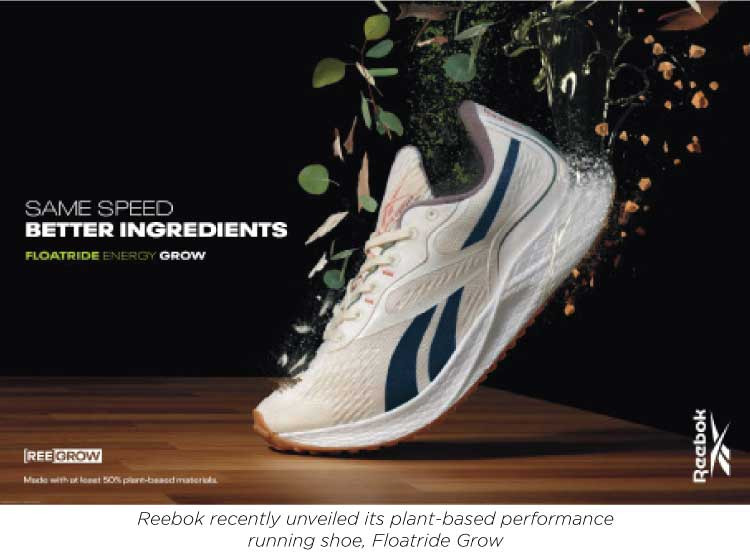
On the other hand, the general perception among Indian consumers is that a sustainable product is going to be more expensive. The sustainability journey of Indian consumers has certainly leaped, but not across the consumer segments. The market for environmentally friendly products has grown but largely among the well-heeled,  upwardly mobile Indians. “People have become conscious, but that is only a tiny sliver”, notes Jessie Paul, Founder, and CEO, Paul Writer, a marketing strategy and brand consulting firm.
upwardly mobile Indians. “People have become conscious, but that is only a tiny sliver”, notes Jessie Paul, Founder, and CEO, Paul Writer, a marketing strategy and brand consulting firm.
It is not just the price barrier, but also the lack of sufficient awareness about the product value that keeps the consumers at arm’s length from sustainable products. “We do a lot of customer experience work, and one of the common things we’ve seen is that the customer doesn’t mind paying extra for the added value that he gets. The current challenge we saw was that customers are not aware of the additional benefits or rather the health hazards that non-sustainable products may cause,” Chatterjee points out.
What consumers also need to know is that every nature-based product is not necessarily sustainable. “The moment you extract an ingredient from a plant you have to use a chemical, as solvents, which automatically means you are not organic. There is so much more as an ecosystem you have to take care of to be organic – no extracts,  packaging, letting the soil rest for five years, not disturbing anything that’s not natural, no chemicals – it is about sustainability in the ecosystem at a larger level”, says Akila Chandrashekhar, Marketing Head, Organic India.
packaging, letting the soil rest for five years, not disturbing anything that’s not natural, no chemicals – it is about sustainability in the ecosystem at a larger level”, says Akila Chandrashekhar, Marketing Head, Organic India.
The sustainability adoption among Indian businesses was on the rise even before the pandemic, but the focus of brands on environmental consciousness got sharper. “There is a significant change over the last couple of years in terms of the focus on adopting some forms of ESG targets or more aggressive pledges. In  the post-pandemic world, the focus on climate change and ESG adoption has intensified. It has become a board room issue”, says Subhranshu Patnaik, Partner, Deloitte India.
the post-pandemic world, the focus on climate change and ESG adoption has intensified. It has become a board room issue”, says Subhranshu Patnaik, Partner, Deloitte India.
The IBM Institute for Business Value study earlier this year showed that the pandemic distinctly changed consumers’ views on sustainability. As per the survey, 78% of respondents from India were willing to change their purchasing behaviour to help reduce the negative impact on the environment.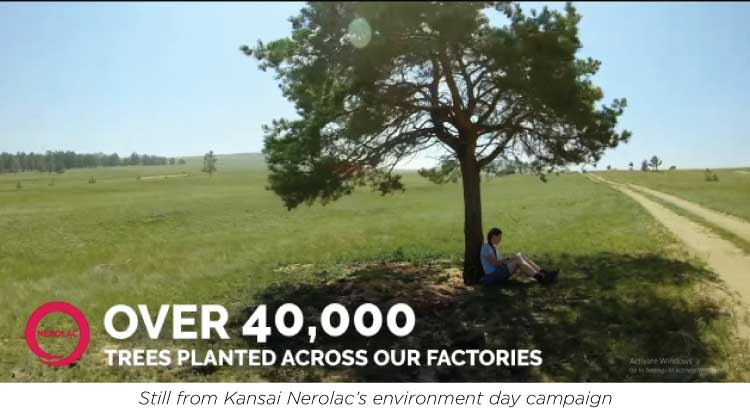
Despite the adoption and push by the pandemic, a larger number of brands in India need to take more decisive steps towards sustainability adoption. It is the large business groups or multinational companies in India that have emerged as trailblazers and walked the sustainability talk. “We’ve seen how big global brands have embraced sustainability to generate more revenue through innovation, collaboration, communication, and commitment. The opportunity is greater than the challenge”, BBDO’s Paul says.
The need for businesses to address environmental issues and societal impact has never been more important. “We support our clients in their sustainability journey by  offering a range of sustainability tools, which help them to reduce carbon footprint and become enablers of positive climate action”, says Viswanathan R, Senior Director, Corporate Real Estate Services, India, Capgemini. The Information Technology services and consulting firm has set a target of achieving carbon neutrality no later than 2025 and becoming a net-zero business by 2030.
offering a range of sustainability tools, which help them to reduce carbon footprint and become enablers of positive climate action”, says Viswanathan R, Senior Director, Corporate Real Estate Services, India, Capgemini. The Information Technology services and consulting firm has set a target of achieving carbon neutrality no later than 2025 and becoming a net-zero business by 2030.
Driving eco-friendly packaging
Packaging can be a key enabler for brands to unfold their sustainability initiative. The talking points of brands adopting sustainable packaging solutions have also intensified, especially because brands have not been able to move the needle when it comes to reducing plastic waste. “India doesn’t have the segregation and collection system in place. How to dispose of sustainably, that cycle is not there today. The waste for recycling needs to head to the recycling plant and not to the landfills. The revolution is in finding a sustainable packaging material so that I don’t have to find a recycling point for the material,” explains Jessie Paul.
Brands driving more and more consumption also result in more waste generation. The situation is such that the recyclable waste is not getting recycled. Plastic waste is finding its way to the drains and open landfills rather than in the brick kilns, where it is supposed to be burnt. “Right now, less than 5%-7% of the products that big  companies produce are recyclable, these are mono polymer-based material, but they do not have a technology or infrastructure to recycle them”, says Jeevaraj Pillai, Joint-President, Packaging UFlex, a multinational packaging material, and solutions firm. The government released a draft of the new Extended Producer Responsibility (EPR) rules in October this year, which would make a manufacturer responsible for managing plastic waste after a consumer has used their product. “We have to see how it is enforced and implemented. It begins right from the registration as a brand owner or a producer and ends as an EPR responsibility which will be cross-tallied; how much is recycled and how much is produced. There is a 360-degree closure of the loop, which will ensure that implementation is taking place”, adds Pillai.
companies produce are recyclable, these are mono polymer-based material, but they do not have a technology or infrastructure to recycle them”, says Jeevaraj Pillai, Joint-President, Packaging UFlex, a multinational packaging material, and solutions firm. The government released a draft of the new Extended Producer Responsibility (EPR) rules in October this year, which would make a manufacturer responsible for managing plastic waste after a consumer has used their product. “We have to see how it is enforced and implemented. It begins right from the registration as a brand owner or a producer and ends as an EPR responsibility which will be cross-tallied; how much is recycled and how much is produced. There is a 360-degree closure of the loop, which will ensure that implementation is taking place”, adds Pillai.
Are brands walking the talk?
Brand differentiating, attractive and innovative packaging, and a more serious regulatory push can only play a limited role in businesses addressing their environmental, social, and governance risks. “The movement is beyond regulation. It is the pressure from your investors, consumers and in certain segments, your employees or prospective employees that will make a difference,” points out Deloitte India’s Patnaik.
Business conglomerate, ITC has a 20-year track record in following sustainability and contributing to the environment, minimising solid waste, carbon dioxide and managing water efficiently. The company adopted Sustainability 2.0 to commit itself to getting aggressive in its vision. “The earlier approach was to just be sustainability  positive. We have stepped up goals in 2.0 to have magnified results. We have insights, and understanding of the scientific practice to create higher capacity for all stakeholders in the medium-term kind of timeline,” explains S Sivakumar, Group Head of Agri & IT Businesses of ITC Limited. ITC even plans to go beyond plastic waste neutrality next fiscal.
positive. We have stepped up goals in 2.0 to have magnified results. We have insights, and understanding of the scientific practice to create higher capacity for all stakeholders in the medium-term kind of timeline,” explains S Sivakumar, Group Head of Agri & IT Businesses of ITC Limited. ITC even plans to go beyond plastic waste neutrality next fiscal.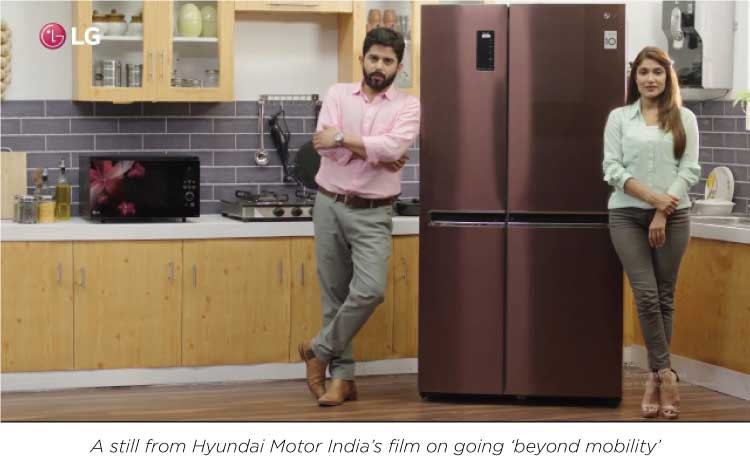
Indian multinational, Dabur also has plans to become a plastic waste neutral organisation by March 2022 by collecting, processing, and recycling 22,000 MT of plastic  waste. “We have already collected, processed, and recycled over 16,600 MT of post-consumer plastic waste by end September this year. The company has taken several initiatives around water management, waste and effluent disposal, and other environment-friendly green initiatives,” states Mohit Malhotra, Chief Executive Officer, Dabur India Limited.
waste. “We have already collected, processed, and recycled over 16,600 MT of post-consumer plastic waste by end September this year. The company has taken several initiatives around water management, waste and effluent disposal, and other environment-friendly green initiatives,” states Mohit Malhotra, Chief Executive Officer, Dabur India Limited.
NCR- based Mother Dairy says that until March 2021, it has collected and recycled or co-processed 7,284 MT of used plastic waste in the country. “Apart from plastics, we are also conscious of efficient usage of key natural resources by bringing them under our performance indicators. Over the years, Mother Dairy has  taken varied measures for environmental sustainability and conservation of natural resources through initiatives like water conservation, rainwater harvesting, adoption of renewal energy sources, mass tree plantation drives, waste management and educating people on the protection of the environment,” says Manish Bandlish, Managing Director, Mother Dairy Fruit & Vegetable Pvt. Ltd.
taken varied measures for environmental sustainability and conservation of natural resources through initiatives like water conservation, rainwater harvesting, adoption of renewal energy sources, mass tree plantation drives, waste management and educating people on the protection of the environment,” says Manish Bandlish, Managing Director, Mother Dairy Fruit & Vegetable Pvt. Ltd.
Many other large multinational corporations like LG, Acer and Ericsson, are rolling out their global sustainability goals in India too. The South Korean conglomerate LG has made public its plans to expand the line-up of energy-efficient products in line with its mission to build a sustainable future. “As we continue to expand our line-up of energy-efficient products, we aim to further reduce our footprint by reducing greenhouse gas emissions generated during production by 50% in comparison to 2017 by 2030,” the company has said in a statement.
Hyundai Motor India Limited has also committed to reducing its carbon footprint and building a cohesive environment for human beings and machines to operate with agility. “We keep sustainability at the core of all our functions and ensure that every step in the making of a car and beyond is sustainable and conducive for the  environment,” says Ganesh Mani, Director-Production, Hyundai Motor India Ltd. Another multinational Nestle aims to recycle or reuse its entire packaging by 2025 globally. It has plans to reach net-zero by 2050.
environment,” says Ganesh Mani, Director-Production, Hyundai Motor India Ltd. Another multinational Nestle aims to recycle or reuse its entire packaging by 2025 globally. It has plans to reach net-zero by 2050.
Kanika Nijhawan, Brand Director, Reebok India tells us that by 2025 the company aims to sell 1 million pairs of the [REE] GROW range and eliminate virgin poly from its products. “We feel that our consumers are at the centre of this initiative and will help drive the brand towards a sustainable future.”  While energy transition is a key factor in helping brands adopt sustainability in manufacturing as well as transportation, the technology breakthrough in green technology for transport, growth of energy storage, and green buildings will catapult sustainability adoption by businesses in India.
While energy transition is a key factor in helping brands adopt sustainability in manufacturing as well as transportation, the technology breakthrough in green technology for transport, growth of energy storage, and green buildings will catapult sustainability adoption by businesses in India.
The green building movement in India kickstarted in the 2000s when Indian Green Building Council (IBGC) and Green Rating for Integrated Habitat Assessment(GRIHA)were founded. Buildings contribute to one-third of global greenhouse gas emissions and consume 40% of the world’s energy. As per IGBC, India has 7.17 billion square feet of green building footprint today. Globally, India’s green buildings growth may be ahead of many other countries, but looking at its sheer size, a lot  needs to be done, particularly in residential real estate. “During this festive season, we also launched our Green Home Loan, where we are giving a certain discount in the interest rate to customers if they buy a green-certified house. Of course, there are terms and conditions around, like what kind of green certification, what the certification agency is, and what level of certification is applied. These are the initiatives nobody’s taken in the industry,” explains Madhvi Gupta, VP, Head of Marketing and Communications, IIFL Home Finance.
needs to be done, particularly in residential real estate. “During this festive season, we also launched our Green Home Loan, where we are giving a certain discount in the interest rate to customers if they buy a green-certified house. Of course, there are terms and conditions around, like what kind of green certification, what the certification agency is, and what level of certification is applied. These are the initiatives nobody’s taken in the industry,” explains Madhvi Gupta, VP, Head of Marketing and Communications, IIFL Home Finance.
There is awareness among brands and consumers towards sustainability. Indian businesses not only need a massive push but a collective approach too. “We are  part of India 2022 Consortium, and work with our clients and campaign strategies that focus on sustainability. It cannot be done alone – we all need to come together and adopt a collaborative approach,” remarks CVL Srinivas, Country Manager, WPP, India. The brands that have embarked on the road towards sustainability will be the ones winning consumers’ confidence. Those who haven’t should get ready to walk the talk on sustainability. India will need to adopt a definitive and aggressive path if it has to meet its net zero goals by 2070. In the words of the UN Secretary-General António Guterres, “there is no time for delay and no room for excuses.”
part of India 2022 Consortium, and work with our clients and campaign strategies that focus on sustainability. It cannot be done alone – we all need to come together and adopt a collaborative approach,” remarks CVL Srinivas, Country Manager, WPP, India. The brands that have embarked on the road towards sustainability will be the ones winning consumers’ confidence. Those who haven’t should get ready to walk the talk on sustainability. India will need to adopt a definitive and aggressive path if it has to meet its net zero goals by 2070. In the words of the UN Secretary-General António Guterres, “there is no time for delay and no room for excuses.”




